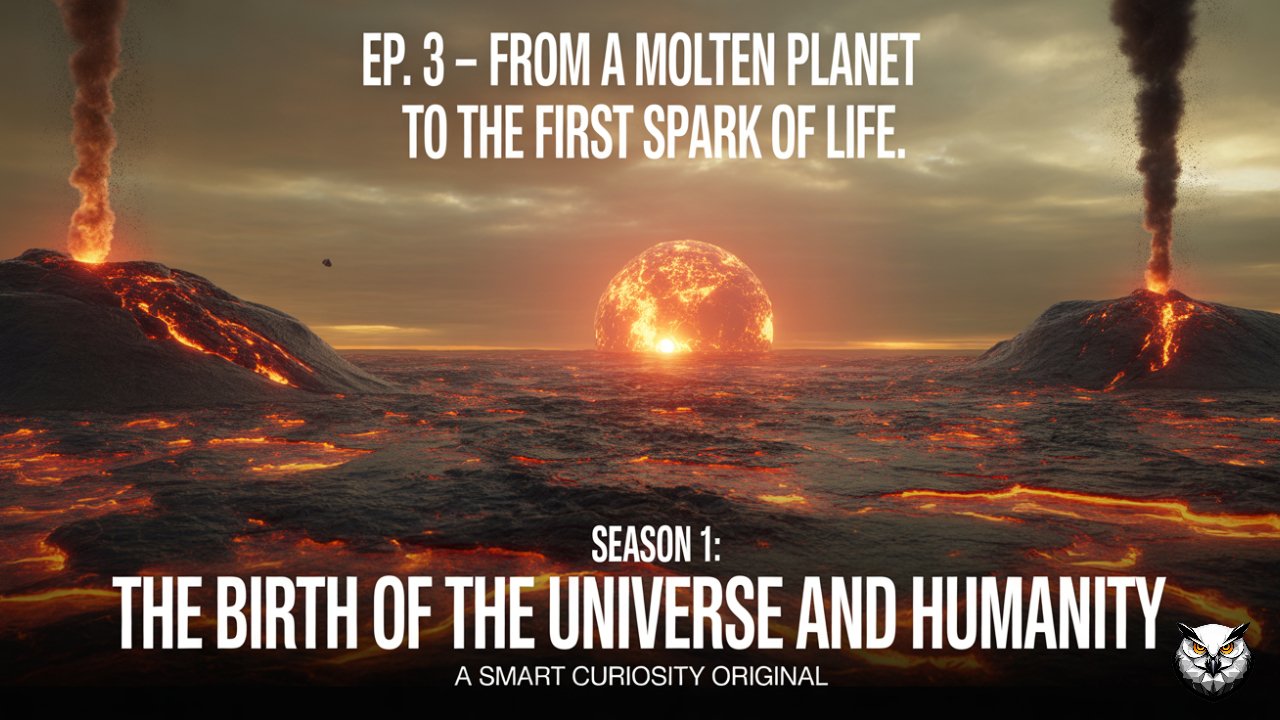Before the gentle blue of our oceans, before the first whisper of wind through the trees, there was a world of fire. Our story doesn’t start on some tranquil, green world. It begins on a cosmic battlefield a hellish ball of molten rock, constantly under siege. For its first half-billion years, the world we now call home was a place of unimaginable violence. A glowing sphere of magma, choking under a toxic sky, and relentlessly pummeled by the leftovers of a chaotic, newborn solar system. The name for this era, the Hadean Eon, comes from the Greek underworld, and for good reason. It was, by every definition, hell on Earth.
This is the story of how that violent, chaotic world transformed. It’s the epic saga of a planet’s journey from a sea of fire to a cradle of water. It’s a story of cooling, creation, and chemistry a four-and-a-half-billion-year-long detective story where the final chapter is still being written. And at its heart lies the greatest mystery, and maybe the greatest miracle, in our planet’s history: how, in all that sterile, primordial chaos, the first spark of life flickered into existence, setting the stage for every living thing that has ever been. So, how did we get from that… to here?
The Cosmic Forge – A Planet is Born
Our journey kicks off in the quiet aftermath of a star’s birth. Around 4.6 billion years ago, a huge cloud of interstellar gas and dust the leftovers from our Sun’s formation began to collapse under its own gravity. This was the solar nebula. Picture it not as a sudden explosion, but as an impossibly slow gathering, a cosmic ballet choreographed by gravity. In this swirling disc, tiny grains of dust, no bigger than smoke particles, started sticking together.
But there was a problem of scale. How do you get from microscopic dust to a planet thousands of kilometers wide? The answer is a messy, relentless process called accretion. At first, static electricity, like a sock clinging to a sweater, pulled these tiny grains into pebble-sized clumps. As the clumps grew, their own gravity started to take over, pulling in more and more material. The pebbles became boulders, the boulders became asteroids, and the asteroids became planetesimals the building blocks of planets, hundreds of kilometers across.
The solar system back then wasn’t the orderly place we know today. It was a cosmic demolition derby, a violent arena with billions of these planetesimals locked in a gravitational dance of creation and destruction. For millions of years, they smashed into each other. Some shattered, others merged, growing bigger with every collision. Out of this celestial chaos, the protoplanet Earth began to take shape, sweeping up the debris in its path.
This whole process was incredibly violent, and it generated an absolutely immense amount of heat. Every collision turned kinetic energy into thermal energy, heating the growing planet. At the same time, the crushing pressure of its own mass squeezed the interior, and the decay of radioactive elements trapped inside added even more fuel to the furnace. The young Earth just got hotter and hotter until it hit a critical tipping point: the entire planet melted.
This led to a world-defining event known as the Iron Catastrophe. In this global ocean of magma, the heavier elements, mainly iron and nickel, were free to move. Pulled by gravity, they sank towards the planet’s center, pushing the lighter, silicate materials up toward the surface. This sorting process, which took tens of millions of years, gave our planet its basic structure: a dense, metallic core, a vast, rocky mantle, and the beginnings of a crust. This wasn’t just geological bookkeeping; it was planetary life insurance. That swirling liquid iron core would generate Earth’s magnetic field a protective shield that, hundreds of millions of years later, would be essential for holding onto an atmosphere and protecting any life that might show up.
For now, though, our world was a glowing, incandescent sphere. A planet of fire. There was no solid ground, no water, and no air. It was a blank canvas, waiting for the next, even more violent, act of creation.
The Age of Fire and Fury – The Hadean Eon
The problem with being a brand-new planet is that you’re not alone. The solar system was still a messy, dangerous place, and Earth was basically a cosmic punching bag. The era we call the Hadean, from roughly 4.5 to 4 billion years ago, was defined by two things: fire and bombardment. The planet was still glowing hot from its formation, its surface a roiling sea of magma. But the biggest challenge was still on its way.
Early on, our young world suffered the single most important impact in its history. A rogue protoplanet about the size of Mars, which scientists have named Theia, slammed into Earth. This wasn’t a glancing blow. It was a world-shattering cataclysm. The impact was so powerful it likely re-melted the entire planet, and a colossal cloud of vaporized rock and debris was blasted into orbit. Over time, this ring of incandescent rubble was pulled together by gravity, eventually forming our Moon.
This was a game-changing moment. The giant impact tilted Earth on its axis, giving us our seasons. The gravitational pull of our new, large Moon stabilized Earth’s wobble, preventing the kind of chaotic climate swings that would have made life much harder to get started. It also locked the Moon into a tidal dance with Earth a dance that would stir our oceans for billions of years, and maybe, just maybe, the primordial soup within them.
But the Moon’s creation was just one highlight in a long period of assault. For hundreds of millions of years, the inner solar system was a shooting gallery, and Earth was a primary target. This period is often called the Late Heavy Bombardment, though some scientists now think it was less of a sudden spike and more of a long, slow tapering off of cosmic violence. Either way, a hail of asteroids and comets, some the size of entire countries, rained down from the heavens. Each impact was an extinction-level event before there was anything to extinguish. The energy they released was staggering, easily vaporizing any water that tried to form and melting any crust that was trying to solidify. The surface was in constant turmoil.
The very name Hadean paints a perfect picture of this infernal landscape. But as terrifying as it was, this violent epoch had a purpose. Those very comets and asteroids, the agents of destruction, were also delivery trucks. Locked inside them as ice were vast quantities of water. And they also carried simple organic molecules the chemical building blocks that would one day become very important. They were seeds of creation, delivered by celestial fire.
Slowly, almost imperceptibly, the chaos began to subside. The solar system started to clean itself up. The biggest chunks of debris had either become part of a planet or been flung out of the system entirely. The impacts became less frequent and less intense. For the first time, our planet had a moment of peace. The constant, sterilizing bombardment was ending. At last, the surface of the Earth could begin to cool in earnest. The age of fire was finally drawing to a close, setting the stage for the next great transformation: the birth of the oceans.
The Planet Breathes – Forging an Atmosphere and Oceans
With the great bombardment fading, Earth had a new challenge. It was still incredibly hot, a barren rock in the vacuum of space with no real atmosphere and no liquid water. It was a sterile, silent world. The solution would come not from the sky, but from deep inside the planet itself.
As the molten surface finally cooled and hardened, it formed a thin, fragile crust, constantly being broken and reformed by the churning mantle below. This kicked off an era of volcanism on a scale that dwarfs anything we see today. Volcanoes all over the globe began to exhale, spewing out the gases that had been trapped inside Earth during its formation. This process, called outgassing, was the birth of our planet’s first real atmosphere.
But this was not the sky we know. The air of the early Earth was a toxic, suffocating cocktail of water vapor, carbon dioxide, and nitrogen, along with pungent methane, ammonia, and sulfur compounds. And critically, there was almost no free oxygen. The sky was likely a hazy orange or reddish-brown, and the atmospheric pressure could have been hundreds of times what it is today. It was an alien sky thick, heavy, and totally unbreathable.
Yet, within this toxic brew was the key to everything: water. An almost unimaginable amount of water was locked in the atmosphere as vapor. As the planet continued its slow, steady cooling, it reached one of the most important tipping points in its history: the surface temperature finally dropped below 100 degrees Celsius (212° F).
What happened next was the greatest deluge the world has ever known. The water vapor in that crushing atmosphere condensed into clouds, and it began to rain. This wasn’t a storm. It was a continuous, global downpour that may have lasted for millions of years. Hot, acidic rain fell from the thick sky, striking the new volcanic rock of the crust. It filled the vast basins and the colossal impact craters left over from the bombardment. Century after century, the water level rose.
Slowly, over eons, the first oceans were born. And these weren’t our calm, blue oceans. They were hot, acidic, and likely a murky olive green from all the iron dissolved out of the volcanic rock. The planet had transformed from a ball of fire to a water world, a globe-spanning ocean simmering under a thick, hostile sky.
This was it. The planet was no longer a dry, barren rock. It now had the single most important ingredient for life as we know it: liquid water. These primordial oceans became a vast chemical laboratory. They held dissolved minerals from the crust, gases from the atmosphere, water from comets, and organic molecules that had hitched a ride on asteroids. The stage was set. All the raw materials were here. All that was needed was a spark.
The Cauldron of Creation – The Search for Abiogenesis
And here we arrive at the heart of our story, and one of the deepest questions in all of science. We have a planet with a stable crust and vast oceans of liquid water full of interesting chemicals. But it’s still a sterile world. It’s a world of chemistry, not biology. The problem is monumental: how do you get from non-living stuff to the first living thing? This process is called abiogenesis, and it’s the holy grail of origins research.
To build life, you need three key things: building blocks, a place to assemble them, and an energy source. The early Earth had all three in abundance. The building blocks were simple molecules like methane, ammonia, and carbon dioxide. The assembly plant was the entire global ocean, a planetary-scale beaker. And the energy was everywhere. With no protective ozone layer, the young Sun blasted the surface with high-energy UV radiation. The turbulent atmosphere created colossal lightning storms. And below the waves, geothermal heat poured out from deep-sea hydrothermal vents.
This led to the first major theory of abiogenesis, the famous “primordial soup.” Proposed back in the 1920s, the idea was simple. In warm, shallow pools of water, the combination of simple chemicals and raw energy could spontaneously create more complex organic molecules. Lightning strikes and UV radiation would act like a cosmic engine, breaking molecules apart and letting them recombine into new forms, like amino acids (the building blocks of proteins) and nucleotides (the building blocks of DNA). Over millions of years, these molecules would build up, creating a rich, organic broth.
For decades, this was a brilliant but untested idea. That changed in 1952 with one of the most famous experiments in science history. At the University of Chicago, Stanley Miller and Harold Urey simulated the early Earth in their lab. They created a closed loop of flasks and tubes, heated water to make vapor, mixed it with gases they thought were in the early atmosphere methane, ammonia, and hydrogen and then zapped the mixture with electrical sparks to simulate lightning.
The results were astonishing. The clear water slowly turned a murky pinkish-brown. When they analyzed it, they found they had created amino acids. From a simple mix of inorganic gases and a bit of energy, they had formed some of the fundamental building blocks of life. The Miller-Urey experiment was a landmark achievement. It didn’t prove this is exactly how it happened, but it showed that the jump from simple chemistry to complex organic molecules wasn’t a miracle; it was a plausible, natural consequence of chemistry and physics.
While later research suggests the early atmosphere might have been a bit different, the core idea holds up. Dozens of other experiments with more realistic atmospheric models have also succeeded in making amino acids and other key compounds. The primordial soup remains a powerful model for how the raw materials for life first appeared.
But it’s not the only game in town. Another compelling theory takes us from the sunlit surface to the crushing darkness of the deep ocean: the hydrothermal vent hypothesis. These are deep-sea fissures where superheated, mineral-rich water from the mantle erupts into the ocean. Even today, they are oases of life that run on chemical energy, not sunlight. Proponents argue these vents were the perfect cradle for life, offering protection from destructive UV radiation, a steady source of energy, and all the right chemicals. The intricate mineral structures of these “black smokers” could have acted like tiny compartments, concentrating the molecules and helping them link up.
A third theory suggests the key ingredients weren’t even made on Earth. We know from meteorites that have fallen to Earth that they can be rich in organic compounds, including amino acids. It’s possible that the comets and asteroids that pummeled the early Earth acted as a cosmic delivery service, seeding the planet with pre-made building blocks for life. This doesn’t solve the ultimate origin question, it just moves it somewhere else, but it suggests the primordial soup might have been stocked with extraterrestrial ingredients.
Of course, these theories aren’t mutually exclusive. It’s entirely possible all of them played a role. Maybe building blocks formed in the atmosphere, were delivered from space, and then all of it collected and assembled in deep-sea vents. The question was no longer if the building blocks could be made, but how those blocks got put together to make the first living thing.
The Spark – From Molecules to Life
So, we have our ingredients. The primordial oceans are a rich, organic soup, full of amino acids, nucleotides, and other useful bits. But soup isn’t alive. A pile of bricks isn’t a house. The next great problem, and maybe the hardest one, is making the leap from random chemistry to actual biology. How did these molecules organize themselves, start working together, and make copies of themselves?
The central challenge is a classic chicken-and-egg problem. In life today, DNA holds the genetic blueprint. But DNA can’t do anything on its own. It needs proteins (enzymes) to read its code and build things. But the instructions to build those very proteins are in the DNA. So, which came first? The blueprint, or the workers?
The leading solution to this paradox is the “RNA World” hypothesis. RNA is DNA’s less famous, more versatile cousin. And it’s a remarkable molecule. Like DNA, RNA can store genetic information. But unlike DNA, RNA can also fold itself into complex shapes and act as an enzyme to drive chemical reactions. These are called ribozymes. The RNA World hypothesis suggests that before DNA and proteins, life was based on RNA. Early RNA molecules could have done both jobs: storing the instructions and doing the chemical work of copying themselves. This would create a system of replication and inheritance the foundation of evolution.
But a self-replicating molecule floating in the ocean isn’t a life form. You need a boundary to separate your internal chemistry from the outside world. This is where another key ingredient comes in: lipids. These are fatty molecules that naturally form little bubbles, or vesicles, in water. It’s easy to imagine a self-replicating RNA molecule getting accidentally trapped inside one of these lipid bubbles. That’s a protocell. Suddenly, you have a contained environment. You have an individual. If a mutation in the RNA helps the bubble stay stable or pull in more materials, that protocell will be more successful. This is the birth of individuality, and the beginning of metabolism.
From there, we can sketch out the path forward. Over time, the more stable DNA would have taken over as the master blueprint, and the more efficient proteins would have taken over as the main workforce, leaving RNA as the intermediary we know today.
At some point, one of these protocell lineages just outcompeted all the others. It was so successful that it became the ancestor of every living thing on Earth today. We call this organism the Last Universal Common Ancestor, or LUCA. LUCA wasn’t the first life, but it’s the most recent ancestor we all share. Based on the genes that are common to all life, we can infer what LUCA might have been like. It was likely a single-celled organism, living without oxygen, probably in very hot, iron-rich water near a hydrothermal vent. Genetic studies suggest LUCA could have existed somewhere between 4 and 3.5 billion years ago, meaning life may have emerged incredibly quickly after the planet became habitable.
Physical evidence is scarce, but our oldest undisputed fossils are structures called stromatolites. These are layered rock formations created by mats of microbes in shallow water, dating back around 3.5 to 3.7 billion years. They are a silent testament that the spark had been lit, and life had taken hold.
Our story started on a world of fire, a molten sphere under constant attack. We journeyed through an age of unimaginable violence, saw the birth of our Moon, and watched as a rain of asteroids shaped our world. We saw the planet exhale its first toxic atmosphere and watched as a million-year-long rainstorm gave birth to the oceans.
Within that primordial cauldron, a great chemical experiment began. Simple molecules, powered by raw energy, assembled into the complex building blocks of life. Those blocks learned to work together, to store information, to replicate, and to wrap themselves in a protective bubble. The profound, and still mysterious, gap between non-living chemistry and self-sustaining biology was crossed. Life had begun.
Every plant, every animal, every fungus, every bacterium, every single one of us, is a direct, unbroken descendant of that first, fragile spark. The four-billion-year chain of replication that started in a primordial soup or a deep-sea vent connects us all. We are the current chapter in a story that began in cosmic dust and stellar fire. The journey from a molten planet to a living one is the ultimate transformation. Life had conquered its own planet. The question was no longer if it would survive, but where it would go next.
If you found this journey through four billion years of history as awe-inspiring as we do, consider subscribing for more stories about our incredible universe. This story is always unfolding, with new discoveries changing our understanding every year. So let us know in the comments below: which origin of life theory primordial soup, deep-sea vents, or cosmic delivery do you find most compelling? Thanks for watching.





